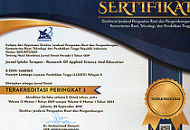ANALYSIS OF ACCURACY IMPROVEMENT IN RANDOM FOREST USING PRINCIPAL COMPONENT ANALYSIS (PCA)
Hanna Willa Dhany(1*), Muhammad Iqbal(2)
(1) Universitas Pembangunan Pancabudi Medan
(2)
(*) Corresponding Author
Abstract
Keywords
Full Text:
References
[1] Agjee Na’eem Hoosen., Mutanga Onisimo., et al. 2018. The Impact of Simulated Spectral Noise on Random Forest and Oblique Random Forest Classification Performance. Journal of Spectroscopy.
[2] Chang, C., Wu, Y., Hou, S. 2009. Preparation and Characterization of Superparamagnetic Nanocomposites of Aluminosilicate/Silica/Magnetite, Coll. Surf. A336: 159,166.
[3] Dai Qin-yun,. Zang Chun-Ping., Wu Hao. 2016. Research of Decision tree Classification Algorithm in Data Mining. Dept. of Electric and Electronic Engineering, Shijiazhuang Vocational and Technology Institute. China
[4] Hussain, H., Quazilbash. N.Z., Bai. S. &Khoja, S. 2015. Reduction of Variables for Predicting Breast Cancer Survivability Using Principal Component Analysis.International Conference on Computer-Based Medical Systems, pp. 131-134.
[5] Manasi M. Phadatare, Sushma S. Nandgaonkar. 2014. Uncertain Data Mining usig Decision Tree and Bagging Technique. Department of Computer Engineering, India.
[6] Pal. M. 2007. Random Forest Classifier for Remote Sensing Classification. National Institute of Technology, Department of Civil. Haryana
[7] Patel, B. N., Prajapati G. Satish., Lakhtaria I. Kamaljit. 2012. Efficient Classification of Data Using Decision Tree. Bonfring International Journal of Data Mining, Vol. 2, No.1.
[8] Paul Angshuman, Mukherjee Dipti Prasad, et.al. 2018. Improved Random Forest for Classification. IEEE Transaction on Image Processing Volume: 27, Issue:8
[9] Seema., Rathi Monika., Mamta. 2012. Decision Tree: Data Mining Techniques. Department of Computer Science Engineering. India.
[10] Yang Bo-Suk., Di Xiao., and Han Tian. 2008. Random Forests Classifier for Machine Fault Diagnosis. Journal of Mechanical Science and Technology 22.
Refbacks
- There are currently no refbacks.
Copyright (c) 2020 Hanna Willa Dhany

This work is licensed under a Creative Commons Attribution-ShareAlike 4.0 International License.
Online ISSN : 2460-5611 | Print ISSN : 1979-9292
Publish by LLDIKTI Wilayah X (Sumatera Barat, Riau, Jambi dan Kepulauan Riau)
Jl. Khatib Sulaiman No 1 Kota Padang. Kode Pos 25144. Telp 0751-7056737. Fax 0751-7056737. Website:http://www.kopertis10.or.id
This work is licensed under a Creative Commons Attribution 4.0 International License.








.png)






_(1).jpg)



